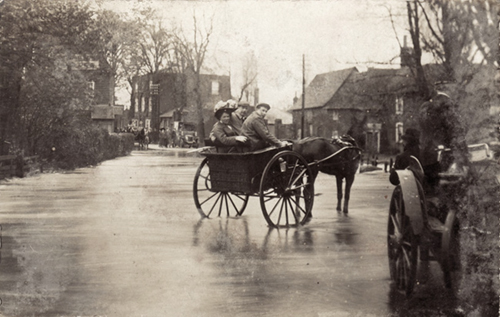~ STURRY ~
KENT

I originally thought that this card was Military Road - the sign on the left reads "...opards Head," which is likely "Leopards Head"
I'm very grateful to the
CURTIS family for supplying this photo postcard for the site
It turns out this photograph is of Sturry, Kent, thank you to David for this information and the write-up below:
"This Leopard's Head, however, is not
the one in Canterbury, but was to be found 3 miles out of city at
the village of Sturry. The flooding depicted took place in November
1909, and was the worst in Sturry and Canterbury for 90 years, following
four inches of rain over a three-day period. The scene is taken with
Canterbury behind the photographer, facing north-east, standing on
the main road between the two places, where it curved over the river
Stour bypassing the Black Mill (out of shot to the right). Post-World
War Two, the mill having been demolished, the alignment of the main
road was straightened with a new bridge, but both old and new bridges
still stand side by side to this day, the former used as parking by
a car showroom!
The buildings in the picture still stand today; from left to right,
the Leopard's Head (now a private residence), Bridge House, and a
sprawling complex called either Old Mill House, Black Mill House,
or similar (I must have a look next time I go past!) Just out of shot
in the distance, Bridge House stands by a second, hump-backed, bridge
that carries the main road over a mill pond serving the White Mill,
standing in the trees to the left. This mill was also demolished in
1940, apparently to remove a tempting landmark for the Luftwaffe (but
did not stop the village being wrecked by two bombs in 1941).
The horse and cart in the picture were provided by the County Council
to convey passengers over the worst part, and must have been quite
fast flowing water, as the paper reported that a lady cyclist was
washed off her bike, and was rescued by some men before ending up
in the river!
The Leopard's Head was a Rigden's establishment, and remained a pub
until the 1930s, when it became tea rooms. In 1954, Frank Neaves,
Motor Engineer, used it until 1973, when it became the Viking Garage.
A much larger garage and showroom was built next door, and is a Mercedes-Benz
business today, using the aforementioned old bridge as parking."
